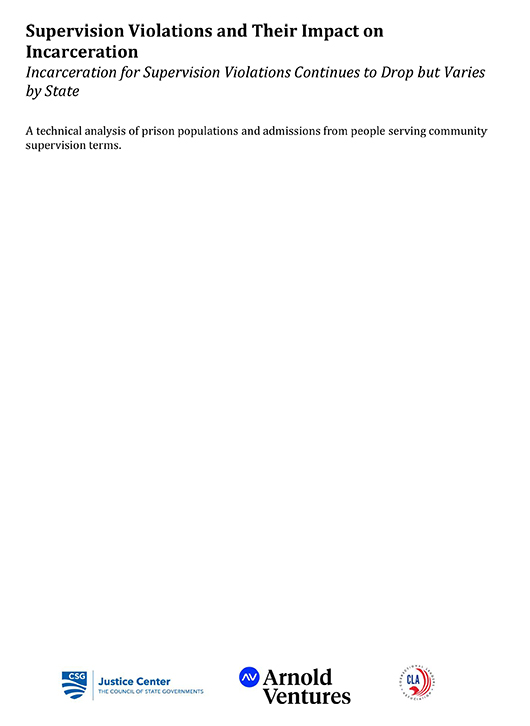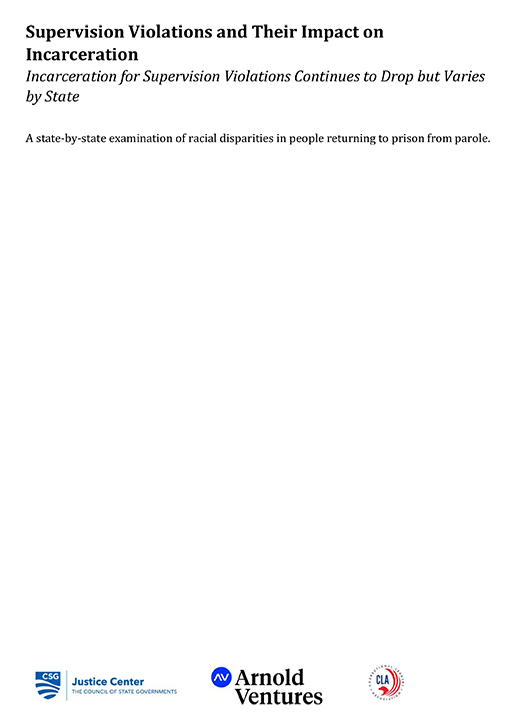In July 2019, in partnership with the Correctional Leaders Association (CLA) and Arnold Ventures, The Council of State Governments (CSG) Justice Center released a report detailing the prevalence of supervision violations among state prison admissions and populations for nearly every state in 2017. Since then, these partners have worked together to collect annual survey data from all 50 state departments of corrections on their prison admissions and populations (resulting in data from 2018, 2019, 2020, and 2021).
The intention of these data collections has been to help to build state capacity to report on the impact of supervision violations on prison admissions and populations more accurately and to better understand how supervision revocation populations change year to year. Please see GitHub for full documentation of the methodology and data availability for each metric.
Number of Admissions and People Incarcerated from Community Supervision by State
In these surveys, states were asked to report on the number of unique admissions to prison from individuals who were serving community supervision sentences, as well as the type of violation that led to the period of incarceration. They were also asked questions about the number of individuals incarcerated on any given day for violating the terms of their community supervision, as well as the types of violations that led to their admissions.
Data across states are not necessarily comparable because of differences in state systems, data definitions, and the data that was available from each department of corrections. However, states provided information about what data they were able or not able to provide, as well as any important context to understanding their data in the survey. These are included in the State Data section of this report under State Notes.
All data are available for download on the website as well.
Glossary of Supervision Violation Terms
- Each admission for a supervision violation or revocation represents one person entering a correctional institution one time because of a violation of a condition of their supervision sentence, either as a sanction or to serve the remainder of their sentence (revocation). Non-violation-related admissions (referred to as “other”) mainly include admissions for new convictions and transfers.
- The population of people who are incarcerated for violating supervision conditions represents the number of individuals incarcerated on any particular day, either as a sanction for violating the terms of their community supervision or as a full revocation to serve the remainder of their sentence. In 2018, 2019, and 2021, that day could be the end of the fiscal year or calendar year. For 2020 only, the CSG Justice Center asked states to use the population on December 30.
- Supervision violations are divided into two general types: (1) A technical violation, which typically occurs when someone fails to meet a supervision condition, usually in the form of missing appointments, not paying fines and fees, or failing drug tests; and (2) a new offense violation, which typically occurs when an individual has committed a new crime while serving their sentence in the community.
Cost of Incarceration Per State
The annual survey also collected information on the average cost of incarceration per individual from each state. The average cost of incarceration is generally calculated as the annual total correctional budget divided by the number of people who were incarcerated. This differs from the marginal cost, which would represent the cost of housing one additional person. Note: since the CSG Justice Center reports the average cost per individual, reliable conclusions cannot be made about how much a state would save or spend if the prison populations change.
Racial Disparities in Admission and Individuals Incarcerated from Parole
To estimate racial disparities, the CSG Justice Center used data from the National Corrections Reporting Program (NCRP) and the National Prisoner Statistics (NPS), both published by the Bureau of Justice Statistics and the Property Owners and Managers Survey Public Use File (POMS), which is published by the U.S. Census. Due to differences in the way each data source records race and ethnicity, only the following categories could be included: White, Black, and Hispanic. The data on Hispanic populations should be interpreted with caution because the original coding for ethnicity in each state system was unavailable and likely varies across states.
With this information, the CSG Justice Center developed four disparity metrics to mirror the data collected in the annual survey, specifically looking at both prison admissions and populations from people on parole. The CSG Justice Center then examined disparities in two different ways: by disparities in parole revocation and by the cumulative disparities in the parole revocation admissions/population. We also provide these metrics by the type of crime an individual was originally convicted of (but not what crime led to the revocation to prison) within the technical reports below.
Key Terms and Details Related to Disparities Data
- The portion of disparities attributable to parole revocations examines the disparities in parole revocations among different racial and ethnic groups. This metric compares the admissions/populations of people who entered prison for parole violations from a racial or ethnic group compared to the representation of people on parole in the same racial or ethnic group.
- Total disparities examine the accumulation of disparities between racial and ethnic groups for people who had their parole revoked. This metric compares the admissions/populations of people who entered prison for parole violations from a racial or ethnic group compared to the representation in the community in the same racial or ethnic group.
- The CSG Justice Center reports each of these in the form of a Relative Rate Ratio (also known as Relative Rate Index, RRI), which compares the rate of any outcome experienced by the Black and Hispanic populations to the rate of that same outcome experienced by the White population. First, rates are calculated by taking the number of people who experienced an outcome within a particular racial or ethnic group in that population. Then rates are compared across populations. An RRI between the Black and White populations of 10-to-1 would indicate that the Black population experienced an outcome at a 10 times higher rate than the White population. An RRI between Black and White populations of less than 1 would indicate that the Black population experienced that outcome at a lower rate than the White population.
For more detailed information about the analysis conducted for this project, download the following reports.


